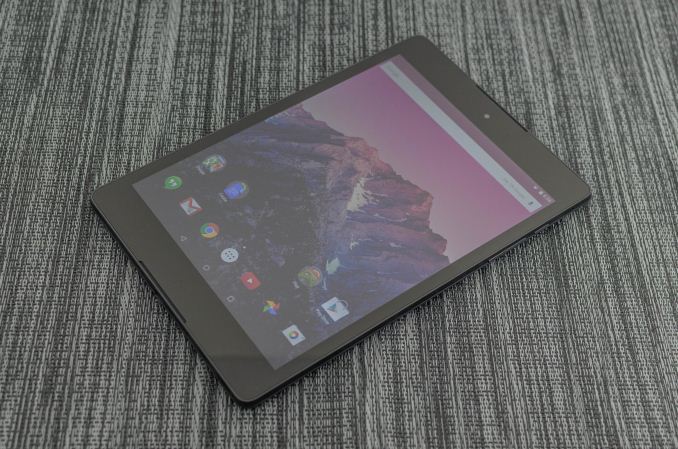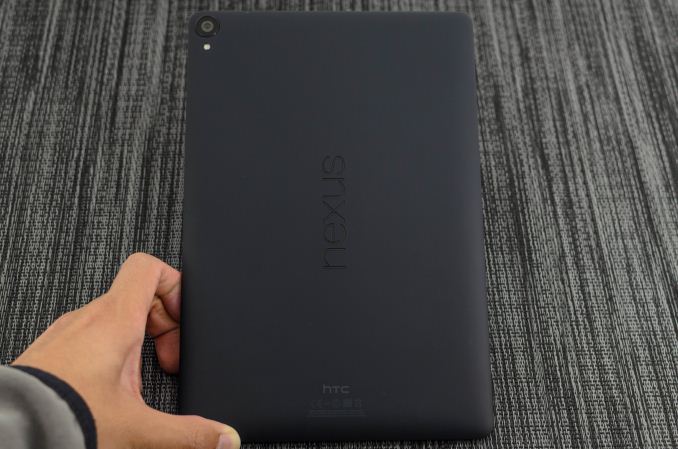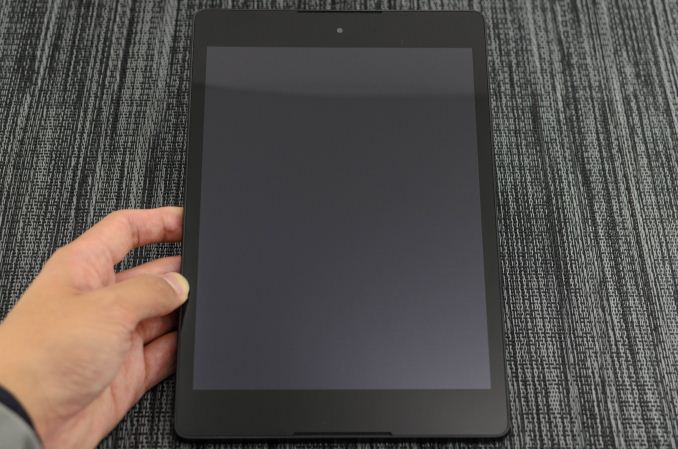The Google Nexus 9 Review
by Joshua Ho & Ryan Smith on February 4, 2015 8:00 AM EST- Posted in
- Tablets
- HTC
- Project Denver
- Android
- Mobile
- NVIDIA
- Nexus 9
- Lollipop
- Android 5.0

For the past few years, we’ve seen Google place significant emphasis on price as a way of competing with other tablets on the market. The original Nexus 7 managed to deliver a good tablet experience without the conventional 500 USD price for a tablet. The successor to the Nexus 7 was even more incredible, as it pushed hardware that was equal to or better than most tablets on the market at a lower price. However, as with most of these low cost Nexus devices not everything was perfect as corners still had to be cut in order to hit these low price points.
The Nexus 9 is supposed to be the polar opposite. Instead of driving price as the primary differentiator, Google has refocused on the high end tablet market for the Nexus 9. With a new focus on industrial and material design, along with some of the latest and greatest hardware in every dimension. HTC has been brought on as a partner for the first time since the Nexus One to enable this vision. In addition, NVIDIA’s Tegra K1 with Denver CPUs can be found inside as the launch platform for Android Lollipop on 64-bit ARM v8. The Nexus 9 also has a 4:3 aspect ratio on its display, a notable departure from the 16:10 ratio that was shared with phones. There’s also the addition of BoomSound speakers on the front and a metal frame running around the edge of the device for improved in-hand feel. The rest of the key specifications can be found below.
| Nexus 9 | |
| SoC | 2.3GHz 64-bit dual core Tegra K1 Denver SoC |
| RAM/NAND | 2GB LPDDR3 + 16/32GB NAND |
| Display | 8.9" 2048x1536 IPS LCD |
| Network | WiFi only or 2G / 3G / 4G LTE SKU |
| Dimensions | 153.68 x 228.25 x 7.95mm, 425g WiFi, 436g LTE |
| Camera | 8MP Rear Facing (IMX219) with F/2.4 aperture, 1.6MP FFC (OV9760) |
| Battery | 6700 mAh (25.46 Whr) |
| OS | Android 5.0 Lollipop |
| Connectivity | 802.11a/b/g/n/ac + BT 4.1 (BCM4354) , USB2.0, GPS/GNSS, NFC (BCM2079x) |
While specs are nice, one of the key areas where the Nexus 9 has to push the limits is in industrial and material design. To this end, Google seems to have mostly delivered, but not quite at the levels that one might have wished. The back continues to be a soft-touch plastic, with almost nothing other than required regulatory text, the Nexus logo, and the camera with its LED flash. I definitely like the feeling of the back cover with its slight outward curve, but on the black model the finish seems to attract smudges quite easily. This is unlikely to be a real problem, but those that are extremely concerned with fingerprint smudges may want to look into getting the white version of this tablet. There is a small amount of give in the dead center of the device, but this is something that one has to actively try to do instead of being immediately obvious. In my experience, the same is true for the Nexus 5 as well which calls into question whether this is a real issue.
Outside of the back cover, the metal rim definitely makes for a significant contrast in texture and feel. The texture seems to be the same as the M8’s gunmetal grey, with an extremely delicate brushed texture. Unfortunately, this does mean that the metal feels glossy in the hand rather than matte, and I suspect that a more standard matte texture would be better in this case. At any rate, it still feels great to the touch, especially when the device is cold. The metal frame has a noticeable outward angle to it, and does make it feel like the One (M7) in that respect. Along the left side of the rim, the device is barren but there is a microUSB 2 port along the bottom and a hole for one of the microphones on the device. Along the right side, we see another microphone hole, the volume rocker, and the power button. While the feel of the buttons is relatively clicky and the actuation is solid, the buttons are definitely a bit on the thin side and are hard to locate and press. The top side has a 3.5mm jack along the top right, and a single plastic line that breaks up the metal frame in line with the speakers.
Speaking of the speakers, unlike the One (M8) and (M7) where the front-facing speakers are a major design element, the speakers on the Nexus 9 are noticeably hidden away from view. They’re definitely present, but the speaker grilles are recessed and black to match the bezels. The recessed nature helps with the design minimalism that is pervasive throughout the Nexus 9, but it does mean that it’s pretty easy for lint and dust to find its way into the grilles. There’s also a noticeable lip around the entire display which makes for a noticeable rounded metal edge, which should help to some extent for drop protection although the thickness of the lip is really quite thin. This means that it can only help with drop protection on flat surfaces. Other than the speaker grilles, the front of the tablet is almost barren. There’s a front-facing camera on the top, and a light sensor to the right of this camera. Other than this, there’s only a single LED at the bottom of the device but it appears that this hasn’t been enabled in the system as I only see it active when charging the device from a fully-depleted state.
Overall, the Nexus 9’s build quality is decent. It isn’t quite as incredible as an all-aluminum unibody, but the feel is quite comfortable and the design fits well with the rest of the Nexus line-up. I do wish the metal frame had a bit more matte feel to it and the buttons do need some work, but I otherwise don’t really have a lot to complain about in this device. It is quite obvious that disassembling the device starts with the back cover though, as it’s pretty easy to stick a fingernail between the back cover and metal frame to pry it apart like the One X.













169 Comments
View All Comments
MonkeyPaw - Wednesday, February 4, 2015 - link
Maybe I missed it, but can you comment on browser performance in terms of tabs staying in memory? I had a Note 10.1 2014 for a brief time, and I found that tabs had to reload/refresh constantly, despite the 3GB of RAM. Has this gotten any better with the Nexus and Lollipop? Through research, I got the impression it was a design choice in Chrome, but I wondered if you could figure out any better. Say what you want about Windows RT, but my old Surface 2 did a good job of holding more tabs in RAM on IE.blzd - Friday, February 6, 2015 - link
Lollipop has memory management issues right now, as was mentioned in this very article. Apps are cleared from memory frequently after certain amount of up time and reboots are required.mukiex - Wednesday, February 4, 2015 - link
Hey Josh,Awesome review. As I'm sure others have noted, the Denver part alone was awesome to read about! =D
gixxer - Thursday, February 5, 2015 - link
There have been reports of a hardware refresh to address the buttons, light bleed, and flexing of the back cover. There was no mention of this in this article. What was the build date on the model that was used for this review? Is there any truth to the hardware refresh?Also, Lollipop is supposed to be getting a big update to 5.1 very soon. Will this article be updated with the new Lollipop build results? Will FDE have the option to be turned off in 5.1?
blzd - Friday, February 6, 2015 - link
Rumors. Unfounded rumors with zero evidence besides a Reddit post comparing an RMA device. All that proved was RMA worked as intended.The likelyhood of a hardware revision after 1 month on the market is basically 0%. The same goes for the N5 "revision" after 1 month which was widely reported and 100% proven to be false.
konondrum - Thursday, February 5, 2015 - link
My take from this article is that the Shield Tablet is probably the best value in the tablet market at the moment. I was really shocked to see the battery life go down significantly with Lollipop in your benchmarks, because in my experience battery life has been noticeably better than it was at launch.OrphanageExplosion - Thursday, February 5, 2015 - link
I seem to post this on every major mobile review you do, but can you please get it right with regards to 3DMark Physics? It's a pure CPU test (so maybe it should be in the CPU benches) and these custom dual-core efforts, whether it's Denver or Cyclone, always seem to perform poorly.There is a reason for that, and it's not about core count. Futuremark has even gone into depth in explaining it. In short, there's a particular type of CPU workload test where these architectures *don't* perform well - and it's worth exploring it because it could affect gaming applications.
http://www.futuremark.com/pressreleases/understand...
When I couldn't understand the results I was getting from my iPad Air, I mailed Futuremark for an explanation and I got one. Maybe you could do the same rather than just write off a poor result?
hlovatt - Thursday, February 5, 2015 - link
Really liked the Denver deep dive and we got a bonus in-depth tablet review. Thanks for a great article.behrangsa - Thursday, February 5, 2015 - link
Wow! Even iPad 4 is faster than K1? I remember nVidia displaying some benchmarks putting Tegra K1 far ahead of Apple's A8X.behrangsa - Thursday, February 5, 2015 - link
Anyway to edit comments? Looks like the K1 benchmark was against the predecessor to A8X, the A7.